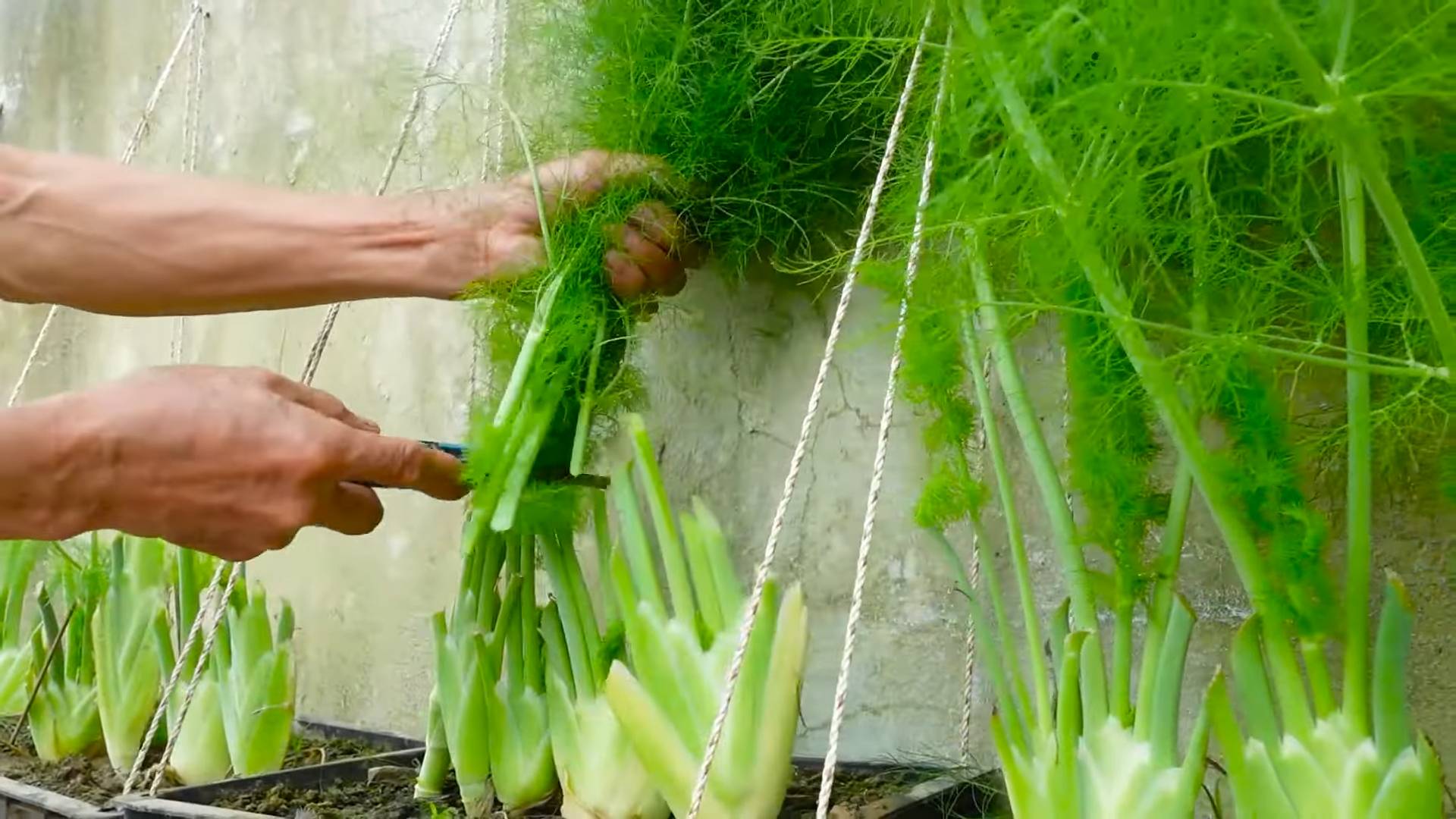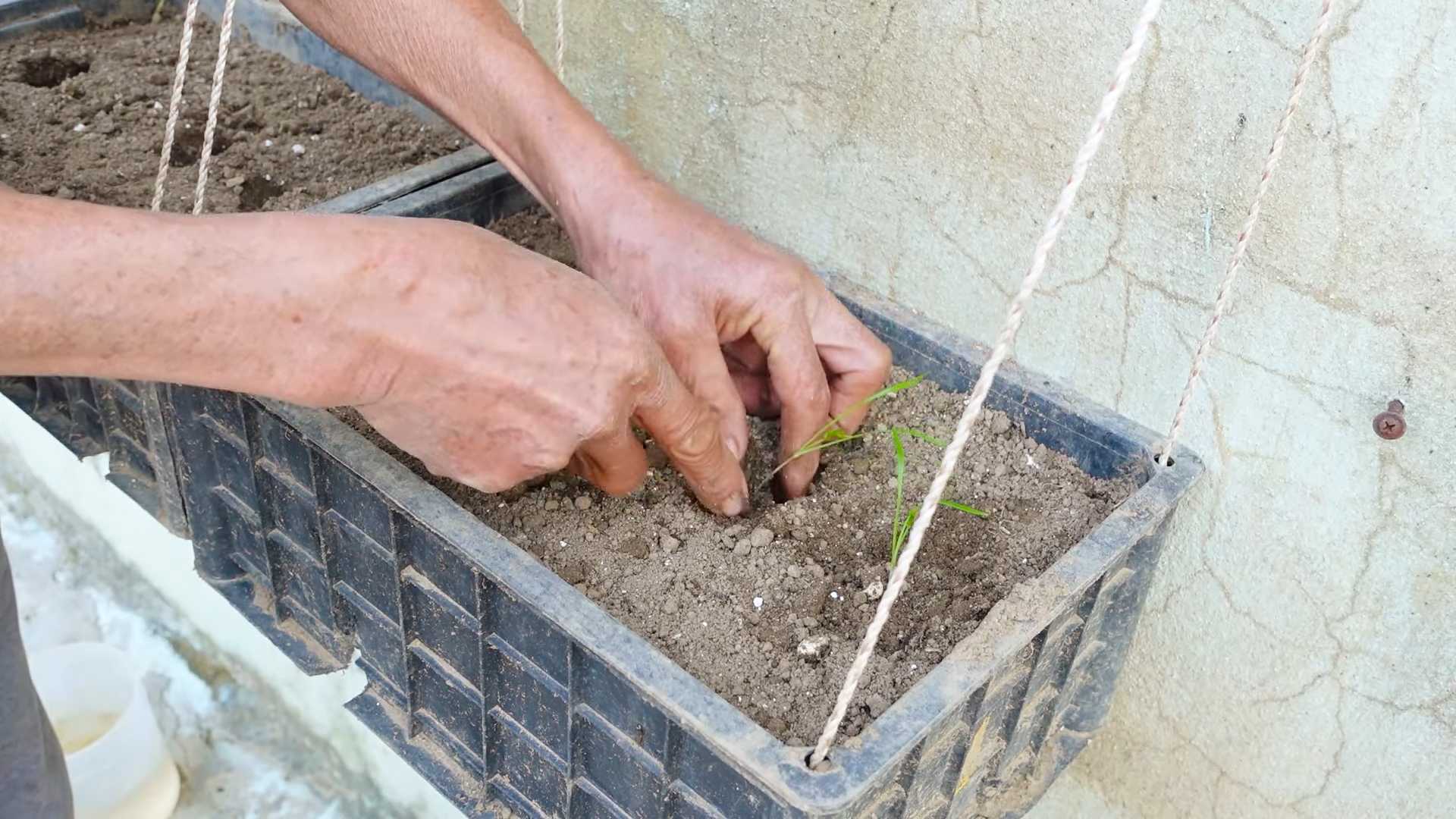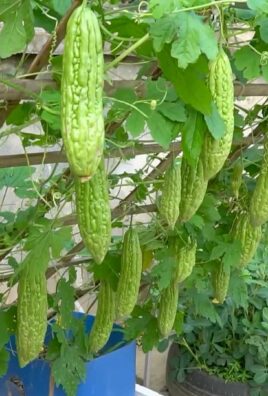Grow Dill Indoors? Absolutely! Imagine having fresh, fragrant dill readily available, even when the snow is falling outside. No more sad, wilted bunches from the grocery store – just vibrant, flavorful dill whenever you need it. For centuries, dill has been cherished not only for its culinary uses but also for its medicinal properties. Ancient Egyptians used it to soothe digestive issues, and Romans believed it brought good fortune.
But let’s be honest, sometimes life gets in the way of a sprawling outdoor garden. That’s where the magic of indoor gardening comes in! I’m here to show you that you don’t need acres of land to enjoy the fresh taste of homegrown herbs. This DIY guide is packed with simple, effective tricks to help you successfully grow dill indoors, regardless of your experience level.
Whether you’re a seasoned gardener or a complete beginner, these hacks will save you time, money, and frustration. We’ll cover everything from choosing the right container and soil to providing the perfect amount of light and water. Get ready to transform your windowsill into a thriving herb garden and elevate your cooking with the unmistakable flavor of fresh, homegrown dill!

Growing Dill Indoors: A Comprehensive Guide
Hey there, fellow plant enthusiasts! I’m so excited to share my secrets for successfully growing dill indoors. Fresh dill is a game-changer in the kitchen, and having it readily available, even in the dead of winter, is pure bliss. Trust me, with a little know-how, you can have a thriving dill patch right on your windowsill. Let’s dive in!
Choosing the Right Dill Variety
Not all dill varieties are created equal, especially when it comes to indoor growing. Some get incredibly tall and leggy, which isn’t ideal for a confined space. I’ve found that these varieties work best:
* Dwarf Dill: As the name suggests, this variety stays compact, making it perfect for containers. It’s also quick to mature.
* Fernleaf Dill: Another great option for smaller spaces, Fernleaf dill is known for its feathery foliage and robust flavor.
* Bouquet Dill: While it can get a bit taller than the others, Bouquet dill is still manageable indoors and offers a high yield of flavorful leaves.
Gathering Your Supplies
Before we get our hands dirty, let’s make sure we have everything we need. Here’s my go-to list:
* Dill Seeds: Choose a variety suited for indoor growing, as mentioned above.
* Potting Mix: Use a high-quality, well-draining potting mix. Avoid garden soil, as it can compact and hinder drainage. I personally prefer a mix specifically formulated for herbs.
* Container: Select a pot that’s at least 6 inches deep and wide. Dill has a taproot, so depth is important. Make sure the pot has drainage holes!
* Grow Lights (Optional but Recommended): Dill needs plenty of light, especially indoors. A grow light can supplement natural light, especially during the darker months.
* Watering Can or Spray Bottle: For gentle watering.
* Small Shovel or Trowel: For planting the seeds.
* Seed Starting Tray (Optional): If you prefer to start your seeds indoors before transplanting.
* Fertilizer (Optional): A balanced liquid fertilizer can help boost growth.
Step-by-Step Planting Guide
Okay, let’s get planting! This is the fun part.
1. Prepare the Pot: Fill your chosen container with the potting mix, leaving about an inch of space at the top. Gently pat down the soil to remove any large air pockets.
2. Sow the Seeds: Dill seeds are small, so handle them carefully. You have two options here:
* Direct Sowing: Sprinkle the seeds evenly over the surface of the soil. Aim for about 5-7 seeds per inch. Then, lightly cover the seeds with about ¼ inch of soil.
* Starting in a Tray (Optional): If you’re using a seed starting tray, plant 2-3 seeds per cell. Cover them lightly with soil. This method allows you to control the environment more closely during germination.
3. Water Gently: Moisten the soil thoroughly with a watering can or spray bottle. Be careful not to dislodge the seeds. The soil should be damp but not soggy.
4. Provide Light: Place the pot in a sunny location that receives at least 6 hours of direct sunlight per day. A south-facing window is ideal. If you’re using a grow light, position it a few inches above the soil surface and keep it on for 12-14 hours per day.
5. Maintain Moisture: Keep the soil consistently moist but not waterlogged. Check the soil moisture daily by sticking your finger about an inch into the soil. If it feels dry, water gently.
6. Germination: Dill seeds typically germinate in 7-14 days. Be patient!
7. Thinning (If Necessary): Once the seedlings emerge and have a few sets of true leaves, you may need to thin them out. If you direct sowed, thin the seedlings so that they are about 2-3 inches apart. If you started in a tray, choose the strongest seedling in each cell and snip off the others at the soil line.
Caring for Your Indoor Dill
Now that your dill is growing, it’s important to provide the right care to keep it healthy and productive.
1. Watering: As mentioned earlier, dill prefers consistently moist soil. Water when the top inch of soil feels dry to the touch. Avoid overwatering, as this can lead to root rot.
2. Lighting: Dill needs plenty of light to thrive. If you’re not using a grow light, rotate the pot regularly to ensure that all sides of the plant receive adequate sunlight. If your dill starts to look leggy (tall and spindly), it’s likely not getting enough light.
3. Fertilizing (Optional): If you want to give your dill a boost, you can fertilize it every 2-3 weeks with a balanced liquid fertilizer diluted to half strength. Follow the instructions on the fertilizer label. I usually skip this step unless my dill looks like it needs a little extra help.
4. Temperature: Dill prefers temperatures between 60-70°F (15-21°C). Avoid placing it near drafts or extreme temperature fluctuations.
5. Pest Control: Keep an eye out for common pests like aphids and spider mites. If you spot any pests, you can try spraying the plant with insecticidal soap or neem oil. I prefer to use a strong stream of water to dislodge them first.
6. Pruning: Regular pruning encourages bushier growth and prevents the plant from becoming leggy. Snip off the top leaves of the plant to promote branching.
Harvesting Your Dill
The best part! You can start harvesting dill leaves once the plant is about 6-8 inches tall.
1. Harvesting Leaves: Use scissors or your fingers to snip off the leaves as needed. Start with the outer leaves and work your way in. Avoid removing more than one-third of the plant at a time, as this can stress it.
2. Harvesting Seeds: If you want to harvest dill seeds, allow the plant to flower. Once the flowers fade and the seed heads turn brown, you can cut them off and dry them upside down in a paper bag. The seeds will fall out as they dry.
Troubleshooting Common Dill Problems
Even with the best care, you might encounter some challenges along the way. Here are a few common problems and how to address them:
* Leggy Growth: This is usually a sign of insufficient light. Provide more light by moving the plant to a sunnier location or using a grow light.
* Yellowing Leaves: Yellowing leaves can be caused by overwatering, underwatering, or nutrient deficiencies. Check the soil moisture and adjust your watering accordingly. If you suspect a nutrient deficiency, try fertilizing the plant.
* Root Rot: Root rot is caused by overwatering and poor drainage. Make sure your pot has drainage holes and avoid letting the soil stay soggy. If you suspect root rot, you may need to repot the plant in fresh soil.
* Pests: As mentioned earlier, keep an eye out for pests and treat them promptly.
Extending the Harvest
To enjoy fresh dill for as long as possible, consider these tips:
* Succession Planting: Plant new seeds every few weeks to ensure a continuous supply of dill.
* Freezing Dill: Dill freezes well. Simply chop the leaves and freeze them in ice cube trays filled with water or olive oil.
* Drying Dill: You can also dry dill leaves by hanging them upside down in a cool, dry place. Once they are completely dry, store them in an airtight container.
Enjoying Your Homegrown Dill
Now that you have a thriving dill plant, it’s time to put it to good use! Here are a few of my favorite ways to enjoy fresh dill:
* In Dips and Sauces: Dill is a classic addition to creamy dips and sauces.
* With Fish: Dill pairs perfectly with salmon, trout, and other types of fish.
* In Salads: Add fresh dill to salads for a burst of flavor.
* In Pickles: Dill is a key ingredient in homemade pickles.
* As a Garnish: Sprinkle fresh dill over soups, stews, and other dishes for a beautiful and flavorful garnish.
Growing dill indoors is a rewarding experience that allows you to enjoy fresh herbs year-round. With a little care and attention, you can have a thriving dill patch right on your windowsill. Happy gardening!

Conclusion
So, there you have it! Growing dill indoors isn’t just a whimsical dream for those of us without sprawling gardens; it’s a genuinely achievable and incredibly rewarding endeavor. We’ve walked through the steps, from selecting the right seeds and containers to providing the optimal light and watering conditions. But why should you even bother?
The answer is simple: fresh, flavorful dill at your fingertips, whenever you need it. Imagine the burst of herbaceous brightness you can add to your favorite dishes, from creamy dips and tangy pickles to perfectly seasoned fish and vibrant salads. No more wilted, overpriced bunches from the grocery store! You’ll have a constant supply of this culinary gem, grown with your own two hands.
Beyond the convenience and cost savings, there’s a unique satisfaction that comes from nurturing a plant from seed to harvest. It’s a connection to nature, a small act of self-sufficiency, and a reminder that even in the smallest of spaces, we can cultivate beauty and abundance.
And don’t think you’re limited to just the standard dill variety. Experiment with different types! ‘Bouquet’ dill is known for its abundant foliage, while ‘Dukat’ dill offers a more intense flavor. You can even try growing dill in different types of containers. Terracotta pots are classic and allow for good drainage, while self-watering planters can be a lifesaver for those of us who sometimes forget to water our plants. Consider companion planting your dill with other herbs like basil or parsley in larger containers for a mini indoor herb garden.
Furthermore, consider the placement of your indoor dill. A sunny windowsill is ideal, but if you don’t have one, don’t despair! Grow lights are an excellent alternative, providing the necessary light spectrum for healthy growth. You can even set up a small hydroponic system for dill, which can accelerate growth and reduce the risk of soilborne diseases.
The key to success with growing dill indoors is consistency and observation. Pay attention to your plant’s needs. Is the soil too dry? Are the leaves turning yellow? Adjust your watering and lighting accordingly. Don’t be afraid to experiment and learn from your mistakes. Every gardener, even the most experienced, has their share of plant failures. The important thing is to keep learning and keep growing.
We truly believe that anyone can successfully grow dill indoors with a little patience and effort. It’s a fantastic way to add fresh flavor to your meals, brighten up your living space, and connect with nature. So, what are you waiting for? Grab some seeds, find a sunny spot, and get started!
We’re confident that you’ll be amazed at how easy and rewarding it is to grow your own dill indoors. And once you’ve harvested your first batch, we want to hear all about it! Share your experiences, tips, and photos with us in the comments below. Let’s create a community of indoor dill growers and inspire others to join the fun. Happy growing!
Frequently Asked Questions (FAQ)
What kind of soil is best for growing dill indoors?
Dill thrives in well-draining soil that is rich in organic matter. A good potting mix specifically formulated for herbs is ideal. You can also create your own mix by combining equal parts of potting soil, perlite, and compost. The perlite helps with drainage, while the compost provides essential nutrients. Avoid using garden soil, as it can be too heavy and may contain pests or diseases. Ensure the soil pH is between 6.0 and 7.5 for optimal growth.
How much sunlight does indoor dill need?
Dill requires at least 6 hours of direct sunlight per day to thrive. A south-facing window is usually the best option. If you don’t have a sunny window, you can supplement with a grow light. Position the grow light a few inches above the plant and keep it on for 12-14 hours per day. Insufficient light can lead to leggy growth and reduced flavor. Rotate the plant regularly to ensure all sides receive adequate light.
How often should I water my indoor dill plant?
Water dill when the top inch of soil feels dry to the touch. Avoid overwatering, as this can lead to root rot. Ensure the pot has drainage holes to allow excess water to escape. During the warmer months, you may need to water more frequently. In the winter, when growth slows down, you can reduce watering. Check the soil moisture regularly and adjust your watering schedule accordingly.
When can I start harvesting dill from my indoor plant?
You can start harvesting dill leaves once the plant is about 6-8 inches tall. Snip off the leaves as needed, being careful not to remove more than one-third of the plant at a time. This will encourage continued growth. You can also harvest the dill seeds once the plant flowers and the seeds turn brown. Dill flowers are also edible and can be used as a garnish. Regular harvesting will encourage the plant to produce more leaves.
How do I prevent pests and diseases from affecting my indoor dill?
Inspect your dill plant regularly for signs of pests or diseases. Common pests include aphids, spider mites, and whiteflies. You can control these pests by spraying the plant with insecticidal soap or neem oil. Ensure good air circulation around the plant to prevent fungal diseases. Avoid overwatering, as this can create a favorable environment for fungal growth. If you notice any signs of disease, remove the affected leaves immediately.
Can I grow dill from seed indoors, or should I buy a seedling?
Growing dill from seed indoors is relatively easy and often more rewarding. Dill seeds germinate quickly, usually within 7-14 days. Start the seeds in small pots or seed trays filled with well-draining potting mix. Keep the soil moist but not soggy. Once the seedlings are large enough to handle, transplant them into larger pots. Buying a seedling is also an option, but it’s important to choose a healthy plant with no signs of pests or diseases.
How do I encourage my dill plant to produce more leaves?
Regular harvesting is the best way to encourage your dill plant to produce more leaves. Pinch off the tips of the stems to promote branching. Ensure the plant receives adequate sunlight and water. Fertilize the plant every few weeks with a balanced liquid fertilizer. Avoid letting the plant flower, as this will signal the end of its life cycle. If flowers do appear, pinch them off to encourage continued leaf production.
My dill plant is turning yellow. What could be the problem?
Yellowing leaves can be a sign of several problems, including overwatering, underwatering, nutrient deficiency, or pest infestation. Check the soil moisture to determine if you are watering too much or too little. If the soil is consistently dry, increase your watering frequency. If the soil is soggy, reduce your watering frequency and ensure the pot has adequate drainage. Yellowing leaves can also indicate a nutrient deficiency. Fertilize the plant with a balanced liquid fertilizer. Inspect the plant for pests and treat accordingly.
Can I transplant my indoor dill plant outdoors?
Yes, you can transplant your indoor dill plant outdoors, but it’s important to acclimate it to the outdoor conditions gradually. Start by placing the plant outdoors in a sheltered location for a few hours each day, gradually increasing the amount of time it spends outdoors. Choose a sunny spot with well-draining soil. Water the plant regularly, especially during the first few weeks after transplanting. Dill is an annual plant, so it will eventually die after flowering.
How long will my indoor dill plant last?
Dill is an annual plant, meaning it completes its life cycle in one growing season. Under optimal conditions, your indoor dill plant can last for several months, providing you with a continuous supply of fresh dill. Once the plant flowers and sets seed, it will begin to decline. You can extend the life of your plant by pinching off the flowers and harvesting the leaves regularly. You can also save the seeds to plant new dill plants.



Leave a Comment